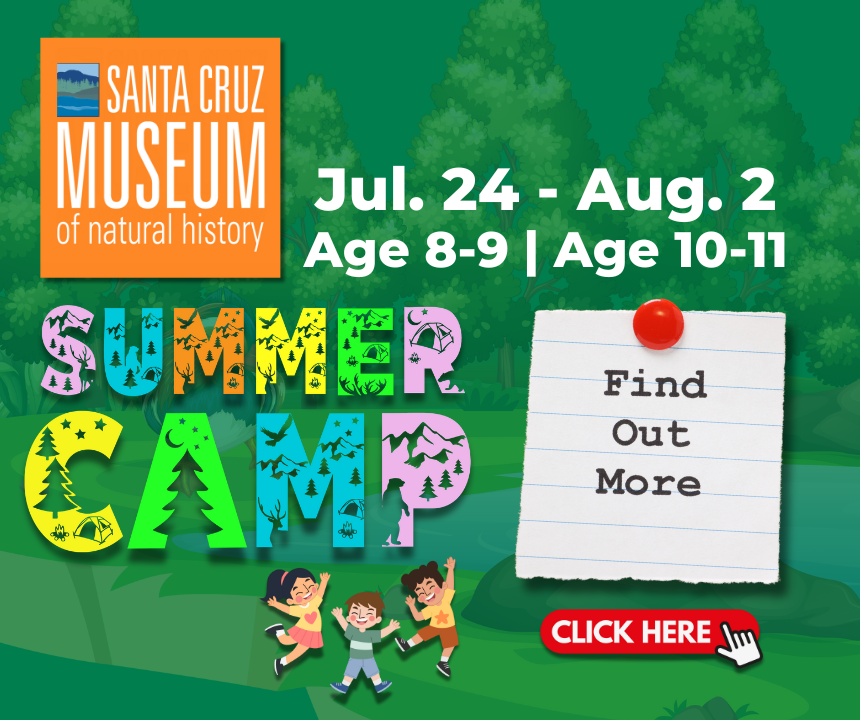At the Kenneth S. Norris Center for Natural History’s symposium in the UCSC Hay Barn, our writer made some friends and discovered some fun facts.
By Bridget Lyons
Feb. 27, 2024—What do pollinator calendars, mammalian lactation fun facts, archival photos of venomous snakes, and the trajectory of Santa Cruz County Supervisor Justin Cummings’ career all have in common? These diverse topics were all explored by speakers at the Norris Center’s 10th Anniversary Natural History Symposium, held Saturday at the UCSC Hay Barn.
You may not have heard of UCSC’s Kenneth S. Norris Center for Natural History. To be honest, I knew very little about it until I biked up to campus to check out this event. I’ve since learned that the center was founded in 2014 to “support natural history education and research opportunities for students, faculty, staff, and the greater Santa Cruz community,” according to the center’s mission statement.
This mission plays out through university field courses, student internships, the curation of collections, and gatherings such as this one—the theme for which was “Building Community Through Natural History.”
That theme was forefronted from the moment I walked in the door, when I was handed a Bingo card. The spaces on the card were filled with phrases that could describe a number of people in the room. In order to fill these spaces with names, I’d have to strike up conversations with some of my fellow natural history geeks while investigating exhibit tables. In between trying to guess whose skull was whose and admiring preserved bat and moth specimens, I introduced myself to a few people. I quickly found out that, while I wasn’t able to help folks fill in the spot on the Bingo card that said, “Has a PhD” or the one that said, “Has done taxidermy,” I could give them my name for, “Has been to Ft. Ord,” and, “Has foraged their own mushrooms.”
In the process of chatting with them, I learned a bit about their natural history passions and their connections to the center. One conversation led to a deep dive into the history of grazing on Santa Cruz County grasslands and the relationship between livestock cultivation and Ohlone Tiger Beetle preservation. I was able to talk with other attendees about what Hilltromper is doing and why I write about critters, landscapes, and wilderness forays. “Right, this is what community-building looks like,” I thought, as I sat down to listen to Justin Cummings describe his own community-oriented path from the South Side of Chicago through UCSC and into local politics. He explained that his passion for and experience in environmental science has enabled him to approach conservation issues from a well-informed perspective.
In addition to meeting people engaged with the more-than-human world, I also got a healthy dose of fun facts (no natural history event is complete without them!). Maddie McNelis’ presentation about her research on lactating mammals offered some great ones: Sea otters eat half of their body weight while nursing. Bears and seals don’t eat at all while nursing. Humpback whales both fast and migrate while nursing. The levels of proteins and sugars in various mammals’ milk varies widely. And the kicker: We just don’t know all that much about lactation in many mammal species. This is problematic, because, as McNelis explained, climate change is applying extra pressure to female mammals who are already under significant biological stress as they participate in “the most physiologically taxing process the body can undertake.”
The Norris Center is committed to strengthening connections between the arts and sciences, and this was evidenced by undergraduate speaker Ty Brown’s presentation of their beautiful pollinator calendar. Brown used locally collected data to create a list of the area’s top pollinators and match them with the plant species they assist. They then created twelve illustrations, one for each month of the year, profiling these pairings. The resulting calendar was for sale at the event and seemed to be flying out the door.
In a similar vein, I stopped by undergrad Nefret Allen-Cantu’s table to check out their “Pollinators and People” poster and hear about how our agricultural system’s overreliance on honeybees decreases the sustainability and reliability of our food sources. Allen-Cantu is an agroecology major, but one with a passion for art who was able to combine these interests to create an infographic that juxtaposed facts with terrific watercolor paintings.
And then there was the concluding activity of the event: hands-on linoleum block printing of plant and animal designs that enabled attendees to walk away with a freshly-inked natural history-themed bandanna.
On my way out the door, I got to exchange my completed Bingo card for a pamphlet called “Mushrooms of the UCSC Campus,” which is going right into my Camelbak for my next mountain bike ride. Knowing it’s in there will encourage me to put on the brakes a few times in order to figure out if the fruiting body I’m seeing is a Fat Jack or a Coccora. Of course, that’s the whole point of giving me the pamphlet. And, if, in addition to pausing to appreciate what I see, I also tell someone about it, then I’d really be bringing the Norris Center’s theme—“building community through natural history”—full circle.
Come to think of it, this is part of what we’re doing here at Hilltromper, isn’t it?
Bridget Lyons is a writer, editor, and explorer living with gratitude in Santa Cruz, CA. You can learn more about her work and find a link to her blog at bridgetalyons.com.
Become part of the Hilltromper community! Subscribe to Hilltromper's free e-newsletter to get the latest articles and events delivered right to your virtual doorstep.
Category:























